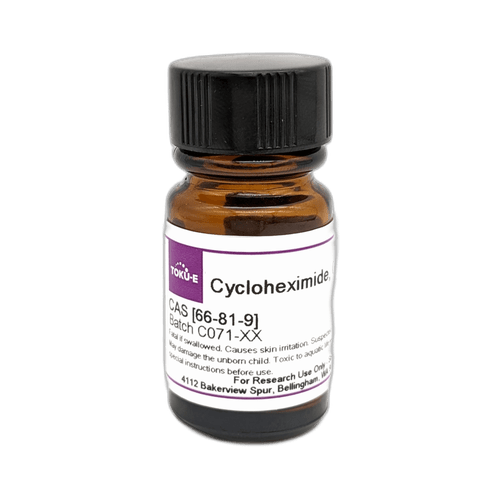Cycloheximide is a glutarimide antibiotic and natural fungicide isolated from Streptomyces griseus and a protein synthesis inhibitor in eukaryotic cells. It was discovered by Alma Whiffen-Barksdale of Upjohn Company in 1946. Cycloheximide is routinely used as a selection agent in several types of isolation media. In molecular biology, it can be used as an experimental tool to determine the half-life of a protein or to study protein synthesis and degradation. Cycloheximide can also be used in protein expression studies, translational profiling and ribosome profiling.
Cycloheximide is soluble in DMSO and ethanol.
This product is considered a dangerous good. Quantities above 1 g may be subject to additional shipping fees. Please contact us for details.
We also offer:
- Cycloheximide Solution (10% in DMSO, Sterile)(C084)
- Cycloheximide, CulturePure® (C071)
- Cycloheximide A, EvoPure® (C123)
- Cycloheximide ReadyMade Solution (C084)
| Application | Cycloheximide is used in molecular biology for ribosome profiling/translational profiling to understand the complexity of translation initiation. Cycloheximide is used to study protein synthesis, expression and degradation, and determine the half-life of proteins. |
| Mechanism of Action | Cycloheximide binds to the ribosome and inhibits the eEF2-mediated translocation step in protein synthesis, thus blocking translational elongation. |
| Spectrum | Cycloheximide is used for fungi and yeast, including fungi found in brewing test media. It has lower activity against bacteria. |
| Microbiology Applications | Cycoloheximide is routinely used as a selection agent in several types of isolation media:
Columbia Blood Agar - Campylobacter Selective supplement (Butzler) Dermasel agar - Selective supplement for dermatophyte fungi Campylobacter Agar - Campylobacter Selective Supplement (Preston) Listeria Selective Agar - Listeria Selective Supplement Listeria Enrichemnt Broth - Listeria Selective Enrichment Supplement Listeria Enrichment Broth - Modified Listeria Selective Enrichemnt Supplement STAA Agar - STAA Selective Supplement Legionella CYE Agar - Legionella GVPC Selective Supplement Campylobacter Agar - Campylobacter Selective Supplement (Karmali) Bolton Broth - Bolton Broth Selective Supplement Representative susceptibility data includes:
For additional Cycloheximide MIC data, please review our Antimicrobial Index. |
| Plant Biology Applications | Cycloheximide is a commonly used for in vitro applications to inhibit fungal growth by targeting protein synthesis. In yeast, concentrations of 200 µM have fungicidal effects (Schneider-Poetsch et al, 2009). The compound can be used as a plant growth regulator to stimulate ethylene production in leaves and fruit. |
| Eukaryotic Cell Culture Applications | Cycloheximide is widely used in biomedical research to inhibit protein synthesis in eukaryotic cells studied in vitro. It inhibits the synthesis of proteins and macromolecules, and affects apoptosis in eukaryotes. Cycloheximide Solution (C084) was used to study transcription factors (LMX1A and LMX1B) in the adult midbrain, contributing to our understanding of dopaminergic neuronal (mDAN) decline in Parkinson’s disease (Jimenez-Moreno et al, 2019). |
| Cancer Applications | Pretreatment with Cycloheximide followed by estrogen stimulation prevented estrogen-induced changes in glucose metabolism in perfused breast cancer T47D clone 11 cells. This suggested that the estrogen stimulation requires synthesis of mRNA and protein (Neeman and Degani, 1989). In studying the “immune escape” of cancer cells, in human colorectal cancer cell line COLO 205 is normally resistant to TNF-alpha, a death inducing ligand. However, co-incubation TNF-alpha with Cycloheximide caused time-dependent cell death. In fact, authors found that Cycloheximide sensitizes cells to TNF-alpha-induced apoptosis (Pajak et al, 2005). |
| Solubility | Soluble in DMSO and ethanol. Solution may be clear to hazy. |
| References | Baliga BS, Pronczuk AW and Munro HN (1969) Mechanism of Cycloheximide inhibition of protein synthesis in a cell-free system prepared from rat liver. J Biol Chem. 244(16):4480-4489 PMID 5806588 Doyle SM, Diamond M and McCabe PF (2010) Chloroplast and reactive oxygen species involvement in apoptotic-like programmed cell death in Arabidopsis suspension cultures. J. Exper. Bot 61 (2):473–482 PMID 19933317 Lee S et al (2012) Global mapping of translation initiation sites in mammalian cells at single-nucleotide resolution. Proc Natl Acad Sci USA. 109(37):E2424-32 PMID 22927429 Neeman M and Degani H (1989) Early estrogen-induced metabolic changes and their inhibition by actinomycin D and Cycloheximide in human breast cancer cells: 31P and 13C NMR studies. PNAS 86 (14):5585-5589 PMID 2748604 Pajak B, Gajkowska B, Orzechowski A (2005) Cycloheximide-mediated sensitization to TNF-alpha-induced apoptosis in human colorectal cancer cell line COLO 205; role of FLIP and metabolic inhibitors. J. Physiol. Pharmacol.56 (3)101-118. PMID 16077198 Schneider-Poetsch T et al (2009) Inhibition of eukaryotic translation elongation by Cycloheximide and lactimidomycin. Nat. Chem. Biol 6: 209-217 PMID 20118940 Cycloheximide (TOKU-E) Jimenez-Moreno N et al (2019) LIR-dependent LMX1A/LMX1B autophagy crosstalk shapes human midbrain dopaminergic neuronal resilience. bioRxiv 636712 Link Buchanan BW, Lloyd ME, Engle SM, and Rubenstein EM (2016) Cycloheximide chase analysis of protein degradation in Saccharomyces cerevisiae. J. Vis. Exp. (110), e53975 |
| MIC | Aphanomyces invadans| 100|| Candida albicans| 12.5|| Mycosphaerella graminicola | 5.62 - 100 || Saccharomyces cerevisiae| 0.05 - 1.2 || Streptococcus pneumonia| >64 || |






